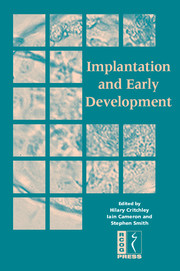Book contents
- Frontmatter
- Contents
- DECLARATION OF INTEREST
- Participants
- Preface
- SECTION 1 PREPARATION FOR IMPLANTATION – THE UTERINE ENVIRONMENT
- SECTION 2 THE EMBRYO
- SECTION 3 LESSONS FROM ANIMAL MODELS (TRANSGENICS) AND NOVEL TECHNOLOGIES
- 15 To implant or not to implant: the role of leukaemia inhibitory factor
- 16 are gene arrays useful for the study of implantations?
- SECTION 4 CLINICAL SEQUELAE
- SECTION 5 CONSENSUS VIEWS
- Index
16 - are gene arrays useful for the study of implantations?
from SECTION 3 - LESSONS FROM ANIMAL MODELS (TRANSGENICS) AND NOVEL TECHNOLOGIES
Published online by Cambridge University Press: 05 June 2014
- Frontmatter
- Contents
- DECLARATION OF INTEREST
- Participants
- Preface
- SECTION 1 PREPARATION FOR IMPLANTATION – THE UTERINE ENVIRONMENT
- SECTION 2 THE EMBRYO
- SECTION 3 LESSONS FROM ANIMAL MODELS (TRANSGENICS) AND NOVEL TECHNOLOGIES
- 15 To implant or not to implant: the role of leukaemia inhibitory factor
- 16 are gene arrays useful for the study of implantations?
- SECTION 4 CLINICAL SEQUELAE
- SECTION 5 CONSENSUS VIEWS
- Index
Summary
Introduction
The recent development of gene expression profiling using DNA microarrays has had a substantial impact on research into endometrial function. This approach allows the abundance of thousands of mRNA transcripts within tissue or isolated cells from endometrium to be measured simultaneously. For the first time, this offers the prospect of understanding the subtle interactions between multiple genes that underlie complex cellular behaviours.
The endometrium is an extremely dynamic tissue that undergoes a series of changes under the influence of steroid hormones during each menstrual cycle. This results in cellular proliferation, maturation and the development of a receptive state, followed by menstruation and endometrial repair. Normal endometrial function therefore involves coordinated interactions between many cell types, including epithelium, stroma, endothelial cells and transient leucocyte populations. Understanding the underlying causes of common endometrial disorders such as menorrhagia, infertility and endometriosis represents a considerable challenge. The traditional approach to the study of such complex systems has been reductionist. Individual pathways and interactions are dissected in isolation in an attempt to explain normal and pathological physiology. Although immensely powerful, this approach has clear limitations. For example, when a cytokine binds to its receptor, several intracellular signalling pathways are activated, including protein phosphorylation, Ca2+ mobilisation and activation of transcription factors. Although we can describe in considerable detail each pathway at the molecular level, it is still impossible to predict the overall effect on cellular behaviour.
- Type
- Chapter
- Information
- Implantation and Early Development , pp. 203 - 216Publisher: Cambridge University PressPrint publication year: 2005

